#oil filler machine
Explore tagged Tumblr posts
Text
Oil Filling Machine - Quality Oil Filler Machine Supplier in Mumbai
Looking for an oil filling machine Supplier and exporter for your industry, then connect with us now at (022)-2500 5773 we are a leading supplier and exporter focussing on Liquid Packaging solutions.
#oil Filler Machine#Oil Filler Machine Manufacturer#Oil Packing Machine#Oil Packing Spplier#Automatic oil Filling machine#Semi-Automatic oil filling machine
0 notes
Text
Sesame Oil Filling Machine Manufacturer from Ahmedabad - Shiv Shakti Machtech
Sesame Oil Filling Machine Manufacturer from Ahmedabad - Shiv Shakti Machtech
#oil filling machine#shiv shakti machtech#manufacturer#ahmedabad#exporter#filler#labeling#capper#labeler
1 note
·
View note
Text
Petroleum Lube Oil Filling Machine

The most popular type of Petroleum Lube Oil Filling Machine for filling liquid in various container types is the bottle filler, often known as the bottle liquid filling machine. Aqueous solutions, foamy liquids, and semi-viscous solutions can all be filled with our selection of filling machines. PET, plastic, glass, aluminum, stainless steel, copper, and other containers can all be filled using bottle liquid filler. Adinath bottle filling machines can be used to fill bottles, jars, containers, and other solid packing types. The foundation structure, piston pump, filling needles, and a conveyor belt with stainless steel slats make up the basic unit.
0 notes
Text






Belgium, fall of 1944. The heat of the summer has given way to cold crisp mornings. The smell of dew-sodden leaves mingles with the stench of high octane fuel and motor oil. The sun has been up for a half an hour, but the crew of a P-61 Black Widow stand near their machine, discussing the details of the night mission they were on only hours before. Two mechanics haul a heavy box of 20mm cannon ammo to the concrete tarmac to begin the re-arming process for the giant fighter. Only a year before, the tarmac was home to German aircraft and German crews. Now, the Americans operate here. As one of the mechanics pulls out a belt of ammo, a rustling is heard amongst the pile of leaves under a maple tree. A white and brown flash darts across the grass, between the cluster of crewmen, and over to one of the mechanics. It's one of the local mutts, and she barks happily at the man in front of her. "Hey Red, I hope you've got some snacks for her!" Shouts the pilot of the plane. "Snacks? That's the last thing this pooch needs, sir!" I'm very pleased to have finished this diorama, and I'm grateful that Dolly let me use her likeness to make/sculpt a 1:72 version of her out of polystyrene and filler putty. She's a good girl.
16 notes
·
View notes
Text
I find it both funny and absurd how Valefor and the Butcher, baddies that in earlier of Worm would have taken an arc or more to take down, are dealt with a chapter each, essentially.
And like, yes, a lot of it is the Undersiders being a far more well-oiled machine and yada yada, but a lot of it is also clearly Wildbow just not wanting to linger. like, the Bakuda Fight wasn't 'fluffed' in the sense that it had tons of filler, but it could have been shorter.
But clearly, Wildbow just wants to speedrun ahead, and yeah, he's also giving Taylor a brief kickass Warlord Arc, thankfully, but in another, probably worse universe, Wildbow devotes like half an arc's worth of chapters at least to both takedowns and the fights drag on forever.
In this case, Wildbow, make kudos, thank you so much for not dragging this out.
#Kylia Reads Worm#Imago 21.6#Look I rag on Wildbow a lot here because I tend to nitpick and complain rather than focus on what I like about a thing#it's just how I use tumblr really it's a habit#But the man is a talented writer and wrote some good stuff#now if only his cultists would not act like he can never do anything wrong or make any mistakes that'd be nice
5 notes
·
View notes
Text
Preventing Defects and Imperfections in Welded Joints

Welding is a critical process used across industries to join metals in the construction of buildings, bridges, automobiles, aircraft, pipelines and many other structures. However, welding is not a perfect process and various types of defects can occur, both internally and externally in the welded metal. These welding defects are imperfections that deviate from acceptable tolerances, weakening the joint and potentially leading to catastrophic failures. Understanding the common types of welding defects, their causes, and preventive measures is crucial for ensuring the integrity and reliability of welded structures. In this article, we will explore the major categories of welding defects, delve into specific defect types, examine their causes, and discuss strategies for preventing their occurrence.
Types of Welding Defects
Welding defects can be broadly classified into two main categories:
External defects: Discontinuities that are visible on the surface of the weld metal
Internal defects: Imperfections that occur within the weld metal and are not readily visible
External Welding Defects
Some of the most common external welding defects include:
Cracks: Fractures that form in the weld metal or heat-affected zone due to thermal stresses, hydrogen embrittlement, or solidification shrinkage
Undercut: A groove-like defect along the edges of the weld bead, reducing the cross-sectional area and weakening the joint
Overlap: Excessive weld metal that flows onto the base material without proper fusion
Spatter: Small droplets of molten metal that solidify on the base material or surrounding area, affecting aesthetics and requiring additional cleaning
Internal Welding Defects
Internal welding defects are not readily visible and often require advanced inspection techniques to detect. Some common internal defects are:
Porosity: Gas bubbles or cavities that form within the weld bead due to trapped gas during solidification
Slag inclusion: Retention of solid materials, metallic or non-metallic, within the weld metal
Lack of fusion: Insufficient bonding between the base material and weld metal or between successive weld beads
Incomplete penetration: The weld does not fully extend through the thickness of the base material, leaving a gap or void
Causes of Welding Defects
Several factors can contribute to the formation of welding defects:
Poor welding technique: Incorrect welding parameters, improper electrode angle, or inadequate travel speed
Incorrect welding parameters: Unsuitable voltage, current, or wire feed speed settings
Contamination: Presence of impurities such as oil, grease, rust, or moisture on the base metal or filler material
Inadequate shielding gas coverage: Insufficient or improper shielding gas flow, leading to atmospheric contamination
Improper joint preparation: Incorrect joint design, poor fit-up, or inadequate cleaning of the joint surfaces
Preventing Welding Defects
To minimize the occurrence of welding defects and ensure high-quality welds, several preventive measures can be implemented:
Proper Welding Technique
Maintain the correct electrode angle and travel speed
Adjust welding parameters based on the material thickness and joint configuration
Ensure proper weld bead placement and overlap
Material Preparation
Thoroughly clean the base metal and filler material to remove contaminants
Ensure proper joint preparation, including beveling and fit-up
Preheat the base metal when required to reduce thermal stresses
Shielding Gas Management
Use the appropriate shielding gas composition and flow rate for the specific welding process and material
Regularly check and maintain the gas delivery system to prevent leaks or contamination
Ensure adequate gas coverage, especially in windy or drafty environments
Equipment Maintenance and Calibration
Regularly inspect and maintain welding equipment to ensure proper functioning
Calibrate welding machines and monitoring devices to maintain accurate settings
Replace worn or damaged components, such as contact tips and gas nozzles
Welder Training and Qualification
Provide comprehensive training to welders on proper techniques, parameter selection, and defect prevention
Ensure welders are qualified and certified according to relevant standards and codes
Encourage continuous learning and skill development through ongoing training and education
Implementing Quality Control Measures
Establish and follow welding procedures and specifications
Conduct visual inspections and non-destructive testing (NDT) to detect and evaluate defects
Implement corrective actions and process improvements based on defect analysis and root cause identification
Detecting and Correcting Welding Defects
Despite preventive measures, welding defects may still occur. Early detection and appropriate corrective actions are essential to maintain the integrity of welded structures. Some common methods for detecting and correcting welding defects include:
Visual Inspection
Examine the weld surface for visible defects such as cracks, undercut, overlap, or spatter
Use magnifying lenses or borescopes for closer inspection of hard-to-reach areas
Document and evaluate the severity of defects based on acceptance criteria
Non-Destructive Testing (NDT)
Employ NDT techniques such as radiographic testing (RT), ultrasonic testing (UT), magnetic particle testing (MT), or dye penetrant testing (PT) to detect internal defects
Interpret NDT results and determine the acceptability of defects based on applicable standards and specifications
Perform additional testing or sectioning for further evaluation if necessary
Corrective Actions
Remove defects by grinding, chipping, or gouging, ensuring complete removal of the defective material
Re-weld the affected area using proper techniques and parameters
Perform post-weld heat treatment (PWHT) when required to relieve residual stresses and improve mechanical properties
Re-inspect the repaired area to confirm the effectiveness of the corrective action
Advancements in Welding Technology
Welding technology continues to evolve, with advancements aimed at improving weld quality, productivity, and safety. Some notable developments include:
Automated welding processes: Robotic welding systems and computer-controlled welding machines enhance precision, consistency, and efficiency, reducing human error and variability.
Advanced welding consumables: New filler materials with improved mechanical properties, corrosion resistance, and weldability enable welding of challenging materials and in demanding environments.
Real-time monitoring and control systems: Sensors, data acquisition systems, and machine learning algorithms enable real-time monitoring of welding parameters, defect detection, and process optimization, leading to improved weld quality and reduced rework.
Conclusion
Preventing defects and imperfections in welded joints is crucial for ensuring the structural integrity, safety, and reliability of welded components across various industries. By understanding the common types of welding defects, their causes, and implementing effective preventive measures, welding professionals can significantly reduce the occurrence of defects and achieve high-quality welds.
3 notes
·
View notes
Photo


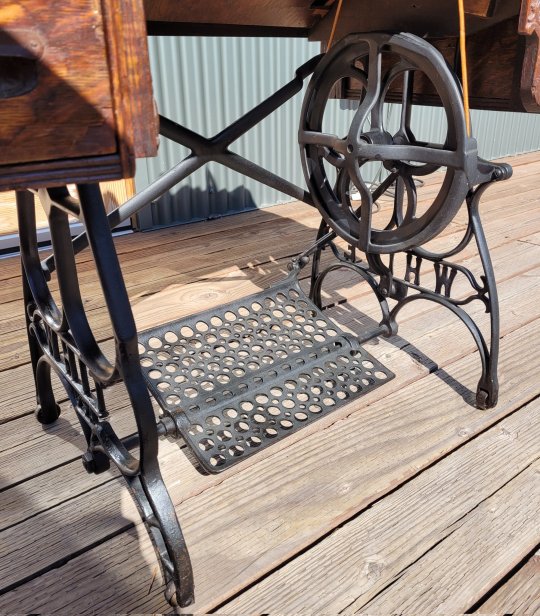
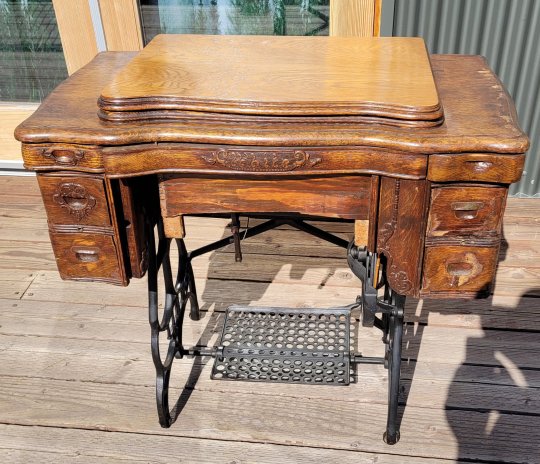
Got the sewing machine up and running first thing in the morning! The only snag I ran into was the needle clamp being gummed up with old sewing machine oil and not being placed back on there correctly by a previous owner. Took it off, gave it a good cleaning, and it slid right back on perfectly and I had no problem installing the needle after!
Tested it by just turning the hand wheel, it took a few tries adjusting the bobbin tension but I got the stitches looking neat and tidy! I’m definitely not used to older machines where you have to manually adjust the tension for the top and bottom threads separately, thankfully it’s pretty easy!
The other 7 hours of my workday were spent out on the office deck, giving the wood a nice wash with oil soap and then oiling the cast iron base. The little bit of cleaning really made the wood pop ;w;
I patched some of the holes in the drawers with wood filler, and also found some finishing nails to stabilize a couple of corners that had come apart over the years. I ordered some fun drawer handles last night, so hopefully I’ll be able to make something that looks nice when they come in!
The last thing I need to do to make it properly functional is treat the leather strap to help it get more grip. It turns fine with the slower speed of the handwheel, but as soon as I get the treadle wheel moving, it’s too fast and the leather strap just sits there. We might have some rosin at home from my mom’s days of playing violin... 🤔
My next step will be consulting with our shipwright to see what he thinks can be done about some of the trickier wood damage that I don’t know how to repair. Every guide I find on patching up wood damage is like “fill it with wood filler then slap some BORING ASS PAINT over your nice 115 year old antique wood stain” which is not going to happen lmao but also means that my internet research isn’t giving me any good leads. I know I could try to match the staining, but that will be tricky without talking to someone who actually knows this stuff.
16 notes
·
View notes
Text
rewatching steven universe future right now and im really appreciatting how... tight this season feels, it feels well planned and like a coherent whole, in a way that prevous seasons constant threat of cancellation and irregular scheduling didnt allow for.
there is a sense that by the time the crew came back for one last season they were a well oiled machine, they had spent 8 years working on something and were practisced in how it was done right, they had the pipeline down, they know what a steven universe season looked like and how it was done. it is no surprise that it feels like the most coherent, the one that has the least noticeable off model moments, the least "filler" episodes, the one with the better constructed overall plot and the one with the strongest sense of continuity to it. this is work done by people who finally, at last, know what they are doing and were given the proper space to tell a story the way it was supposed to be told from beggining to end through the span of one season
11 notes
·
View notes
Text
WHAT IS MAGNESIUM USED FOR IN MANUFACTURING?
Magnesium is a lightweight, durable, and highly versatile metal that has a wide range of applications in various manufacturing industries. This metal is the eighth most abundant element in the Earth's crust and has excellent corrosion resistance, making it an ideal choice for many industrial applications. In this blog, we will explore some of the most common uses of magnesium in manufacturing.
Magnesium metal used for Die Casting:
Magnesium is widely used in die casting applications due to its low density, high strength, and excellent dimensional stability. Magnesium die casting is used to manufacture parts for the automotive, aerospace, and electronics industries, among others. Some of the parts that can be die-cast from magnesium include engine blocks, transmission cases, steering wheels, and laptop and mobile phone frames.
Some of the benefits of die-casting magnesium include:
1. Lightweight: Magnesium is one of the lightest metals available, with a density that is two-thirds that of aluminum and one-quarter that of steel. This makes it an excellent choice for applications where weight is a critical factor, such as in the automotive and aerospace industries.
2. High Strength-to-Weight Ratio:
Magnesium alloys have a high strength-to-weight ratio, making them stronger and more durable than many other materials. This is particularly important in applications where the part must withstand high stress and loads.
3. Good Corrosion Resistance:
Magnesium metal alloys have excellent corrosion resistance, which makes them ideal for use in harsh environments. They are particularly resistant to saltwater and other corrosive substances, making them useful in marine applications.
The combination of low weight, high strength, good corrosion resistance, good thermal conductivity, and excellent machinability makes magnesium an ideal choice for die casting applications.
Magnesium metal used for Welding
Magnesium is also used in welding applications due to its low melting point and excellent heat conductivity. Magnesium welding is used to manufacture components such as aircraft and aerospace parts, bicycle frames, and automotive parts.
Magnesium is a reactive metal that is prone to oxidation, which can create problems when welding. Here are some of the key factors to consider when welding magnesium:
1. Cleanliness: Magnesium must be cleaned thoroughly before welding to remove any oils, grease, or other contaminants that can interfere with the welding process.
2. Shielding Gas: Welding magnesium requires the use of a shielding gas, such as argon or helium, to protect the molten metal from the surrounding air and prevent oxidation.
3. Welding Technique: Magnesium is best welded using the gas tungsten arc welding (GTAW) process, also known as TIG welding. This process allows for precise control of the heat input and minimizes the risk of oxidation.
4. Preheat: Magnesium material should be preheated before welding to reduce the risk of cracking and ensure a strong weld.
5. Filler Metal: Magnesium filler metal should be used when welding magnesium to ensure a strong, durable weld. The filler metal should match the composition of the base metal as closely as possible.
Welding magnesium requires careful preparation and execution to ensure a strong, durable weld. It is important to follow best practices and work with a skilled welder who has experience working with magnesium.
Magnesium metal used for Welding
Magnesium metal used for Extrusion
Magnesium extrusion is used to manufacture a wide range of components for various industries, including automotive, aerospace, and construction. Extruded magnesium components include window frames, door frames, heat sinks, and decorative elements.
Magnesium and magnesium alloys are easy to machine and extrude, which makes them an excellent choice for complex shapes and designs. And magnesium has good thermal conductivity, which means that it can quickly dissipate heat. This makes it useful in applications where heat dissipation is important, such as in electronic devices and automotive parts.
Overall, the combination of low weight, high strength, good corrosion resistance, excellent machinability, and good thermal conductivity makes magnesium an ideal choice for extrusion applications. It is important to note, however, that magnesium is a reactive metal and must be handled carefully to prevent oxidation during the extrusion process. Special precautions must be taken to ensure that the metal is properly protected from the surrounding atmosphere during extrusion.
Magnesium metal used for Extrusion
Magnesium metal used for Sheet Metal Fabrication:
Magnesium sheet metal is used in the manufacture of various components for the aerospace and automotive industries. Magnesium sheet metal is lightweight, strong, and easy to work with, making it an ideal material for producing complex shapes and designs.
Magnesium metal for sale at Yirui Metal can be used for sheet metal fabrication, but there are some important considerations that need to be taken into account. Sheet metal fabrication involves forming, cutting, and joining thin sheets of metal to create a desired shape or structure. Here are some of the key factors to consider when using magnesium for sheet metal fabrication:
1. Cutting and Forming:
Magnesium metal can be cut and formed using many of the same tools and techniques used for other metals. However, it is important to use tools that are designed for use with magnesium to prevent damage to the metal and to ensure a clean, accurate cut.
2. Welding and Joining:
Magnesium material can be welded using a variety of techniques, including gas tungsten arc welding (GTAW), gas metal arc welding (GMAW), and laser welding. However, it is important to take special precautions to prevent oxidation during the welding process, as magnesium is highly reactive.
3. Surface Treatment:
Magnesium materialcan be treated with a variety of surface coatings, such as anodizing or plating, to improve its corrosion resistance or to enhance its appearance.
Magnesium material can be a good choice for sheet metal fabrication when its unique properties are needed. However, it is important to work with a skilled fabricator who has experience working with magnesium and who understands the special precautions that must be taken to prevent oxidation during the fabrication process.
Magnesium metal used for Machining
Magnesium metal is also used in machining applications to produce a wide range of components for various industries, including automotive, aerospace, and electronics. Magnesium can be machined to produce complex shapes and designs, making it an ideal material for producing intricate components such as gears, bearings, and connectors.
Magnesium metal is often used for machining because it is a lightweight and easy-to-machine metal with good mechanical properties. Machining involves using cutting tools to remove material from a workpiece to create a desired shape or finish. Here are some of the key factors to consider when machining magnesium:
1. Cutting Tools:
Magnesium material is a soft metal, so it requires cutting tools that are designed for use with soft metals. Carbide tools are a popular choice for machining magnesium, as they are durable and can be used at high speeds.
2. Lubrication:
Magnesium material can be prone to galling, which is a form of surface damage that can occur during machining. To prevent galling, it is important to use a suitable lubricant during the machining process.
3. Safety:
Magnesium material is a flammable metal and can ignite when exposed to heat or sparks. It is important to take proper safety precautions when machining magnesium, such as using fire-resistant barriers and ensuring proper ventilation.
4. Surface Finish:
Magnesium material can be machined to a high degree of accuracy and can achieve a smooth surface finish. However, care must be taken to avoid creating burrs or other defects during the machining process.
Magnesium is a good choice for machining when its unique properties are needed. However, it is important to work with a skilled machinist who has experience working with magnesium and who understands the safety considerations that must be taken when machining this metal.
Magnesium metal used for Powder Metallurgy
Magnesium is also used in powder metallurgy applications to manufacture a wide range of components for various industries, including aerospace and automotive. Magnesium powder metallurgy is used to produce components such as engine parts, gears, and bearings.
Magnesium metal can be used for powder metallurgy, a manufacturing process that involves forming metal powders into a desired shape or structure using heat and pressure. Here are some of the key factors to consider when using magnesium for powder metallurgy:
1. Powder Production:
Magnesium powders can be produced using a variety of techniques, including atomization, chemical reduction, and mechanical milling. The choice of production technique depends on the desired powder characteristics, such as particle size, shape, and purity.
2. Forming:
Magnesium alloy powder can be formed into a desired shape or structure using various techniques, such as hot pressing, cold pressing, or injection molding. Care must be taken to ensure that the powder is properly consolidated and that the final part has the desired properties.
3. Sintering:
After forming, the magnesium part is typically sintered at high temperatures to create a fully dense, solid structure. During the sintering process, the powder particles are bonded together to create a solid mass.
4. Surface Treatment:
Magnesium parts produced using powder metallurgy can be treated with a variety of surface coatings, such as anodizing or plating, to improve their corrosion resistance or to enhance their appearance.
Magnesium is a good choice for powder metallurgy when its unique properties are needed. However, it is important to work with a skilled metallurgist who has experience working with magnesium and who understands the special considerations that must be taken when working with this metal powder.
In conclusion, magnesium is a highly versatile metal that finds a wide range of applications in various manufacturing industries. Its low density, high strength, and excellent corrosion resistance make it an ideal choice for die casting, welding, extrusion, sheet metal fabrication, machining, and powder metallurgy applications. As technology continues to advance, the use of magnesium is likely to expand further, making it an increasingly valuable material in the years to come.
PREV: Is Magnesium Considered a Heavy Metal?
NEXT: Is Magnesium a Soft Metal?

3 notes
·
View notes
Text
How To Make The Most Of 304 Stainless Steel Round Bar?
304 stainless steel round bar is one of the most broadly occupied materials in an assortment of businesses because of its flexibility, erosion resistance, and amazing formability. Its combination of chromium and nickel substances makes it perfect for applications where toughness and style are vital. A 304 stainless steel circular bar, in particular, is regularly utilized in fabricating, developing, and designing components that require quality, accuracy, and resistance to natural components. This article explores how to form the foremost 304 stainless steel circular bars, counting key contemplations and applications.
1. Get the Material’s Properties
304 stainless steel is known for its great resistance to erosion, especially in situations uncovered to nourishment, water, and chemicals. Hastelloy fasteners manufacturers also offer great weldability and can be effortlessly manufactured utilizing common machining procedures. These properties make it the best choice for an assortment of applications, such as latches, shafts, bolts, and components within the nourishment handling, car, and marine businesses.
2. Exactness Machining
Three hundred four stainless steel circular bars are frequently chosen for their capacity to resist overwhelming loads and mechanical push. To maximize the material’s potential, it’s critical to utilize accurate machining procedures. CNC (computer numerical control) turning and processing is ideal for forming stainless steel threaded rod circular bars into exact components like shafts, gears, and pins. Legitimate tooling, such as carbide or high-speed steel cutters, ought to be utilized to attain smooth surfaces and tight resiliences. One challenge with machining 304 stainless steel is its work-hardening propensity. It’s vital to utilize ideal speeds and bolsters to maintain a strategic distance from the over-the-top warm era and instrument wear.
3. Welding and Joining
304 stainless steel screws can be welded using strategies such as TIG (Tungsten Inactive Gas) or MIG (Metal Idle Gas) welding. These procedures are well-suited for joining stainless steel since they minimize warm mutilation and give solid, clean welds. It is fundamental to utilize suitable filler materials that coordinate the composition of 304 stainless steel to preserve the material’s quality and erosion resistance at the joint.
Sometimes, recently welded, the surfaces ought to be altogether cleaned to evacuate any contaminants such as oil or rust. Post-weld warm treatment is regularly superfluous for stainless steel hex bolts, but in certain high-stress applications, it may well be required to diminish leftover push and progress the by-and-large quality of the weld.
4. Erosion Resistance in Particular Situations
304 stainless steel is profoundly safe from erosion, but it can be vulnerable to pitting and hole erosion in chloride-rich situations, such as marine or coastal regions. In the event that your venture includes a presentation to these conditions, consider employing a safer combination, such as 316 stainless steel round bar, or joining extra defensive coatings to improve its life span.
5. Applications of 304 Stainless Steel Circular Bar
The flexibility of 304 stainless steel circular bars creates them appropriate for a wide range of applications. Common employments incorporate:
- Clasp and Bolts:
304 stainless steel round bars are commonly utilized to make bolts, nuts, and screws due to their quality and erosion resistance.
- Shafts and Axles:
In apparatus and car applications, 304 stainless steel is utilized for shafts and axles that require resistance to wear and natural stretch.
- Auxiliary Components:
The material is frequently utilized in auxiliary back bars and other engineering components, particularly in applications where appearance and resistance to erosion are imperative.
Wrapping It Up
To create the foremost 304 stainless steel circular bars, understanding the material’s properties and selecting the correct handling strategies are key. Whether you’re machining exact parts, welding basic components, or guaranteeing erosion resistance in requesting situations, 304 stainless steel’s toughness and versatility offer incalculable conceivable outcomes. By following the best practices in creation, you’ll guarantee that your 304 stainless steel components will perform successfully and stand the test of time in an assortment of businesses
0 notes
Text
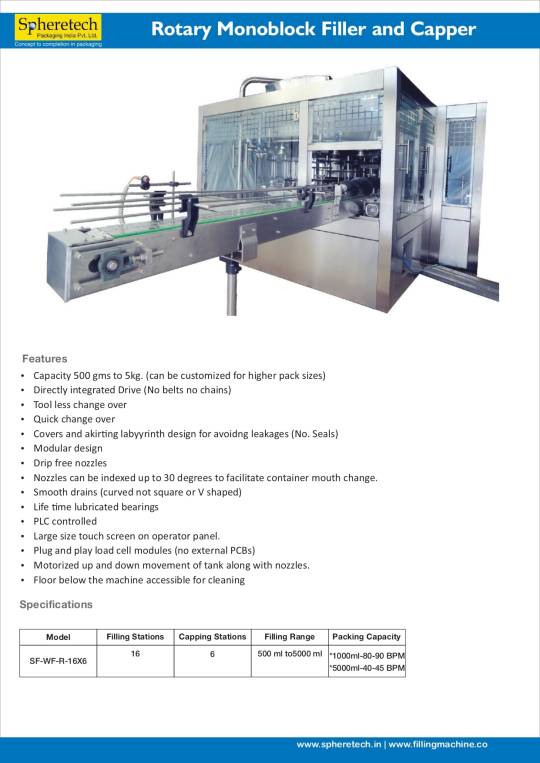
We Provide A Wide Range Of Liquid Filling Machines. We Design Bottle Filling Machines That Can Package Free-Flowing Products Such As Edible Oil, Lube Oil, Wines, Juices, Viscous Products Such As Mango Juice, Sauce, Fruit Syrup, Ghee. We Offer A Complete Range Of Bottle Filling Machine For Glass & Plastic Bottles, Cans & Jar. Visit : https://www.spheretechpackaging.com/
#Mango Juice filling machine#lube oil filling machine#juice filling machine#Fruit syrup filling machine#ghee filling machine#liquid bottle filling machine#Flavoured Milk Filling Machine#lubricant oil filling machine#cooking oil filling machine#edible oil filling machine#oil filler machine#spheretech packaging machine
0 notes
Text
Safflower Oil Filling Machine Manufacturer from Ahmedabad - Shiv Shakti Machtech
#manufacturer#ahmedabad#exporter#safflower oil filling machine#oil filling machine#edible oil filling machine#mustard oil filling machine#filler machine#filler#filling technlogy#servo filling machine#gear pump filling machine#servo pump filling machine
0 notes
Text
Floor Sanding in London: Restore and Enhance Your Wooden Floors

What is Floor Sanding?
Floor sanding is the process of removing the top layer of a wooden floor using abrasive materials to eliminate imperfections, stains, and scratches. It is followed by sealing and finishing to protect the wood and enhance its appearance. The process revitalizes your floors, making them look as good as new.
Benefits of Floor Sanding
1. Restores the Beauty of Wooden Floors
Over time, wooden floors accumulate scratches, scuff marks, and stains. Floor sanding removes these imperfections, revealing the natural beauty of the wood beneath.
2. Increases Durability
Regular sanding and sealing protect the wood, extending the lifespan of your flooring by preventing further damage and wear.
3. Enhances Indoor Air Quality
Dust, dirt, and allergens can accumulate in the crevices of worn wooden floors. Sanding removes these particles, improving indoor air quality.
4. Adds Property Value
A well-maintained wooden floor enhances the aesthetic appeal of your property, increasing its market value.
5. Allows for Customisation
After sanding, you can choose different stains, finishes, and sealants to match your interior decor.
The Floor Sanding Process
Step 1: Inspection and Preparation
A professional floor sanding service will first inspect your floors to assess their condition. Any protruding nails or loose boards are secured, and furniture is removed from the area.
Step 2: Sanding
Using specialized sanding machines, professionals remove the top layer of the wood, starting with coarse sandpaper and gradually moving to finer grits for a smooth finish.
Step 3: Gap Filling (If Necessary)
If there are gaps between floorboards, they are filled with a suitable filler to create a uniform surface.
Step 4: Staining (Optional)
If you want to change the color of your wooden floors, staining is applied at this stage to achieve the desired shade.
Step 5: Sealing and Finishing
A protective sealant or finish is applied to enhance durability and provide a polished look. Options include varnish, oil, or wax, depending on your preference.
Step 6: Final Buffing and Cleaning
The floor is buffed to ensure a smooth surface, and the area is cleaned to remove any remaining dust or debris.
Types of Wooden Floors Suitable for Sanding
1. Solid Hardwood Floors
Solid wood floors can be sanded multiple times and are ideal for refinishing.
2. Engineered Wood Floors
These can be sanded, but only if they have a thick enough top layer of hardwood.
3. Parquet Floors
Parquet floors can also be sanded carefully to maintain their intricate patterns.
Choosing the Right Floor Sanding Service in London
With numerous floor sanding companies in London, selecting the right one is crucial for a successful restoration. Here are some key factors to consider:
1. Experience and Expertise
Choose a company with years of experience and skilled professionals to ensure quality work.
2. Reviews and Testimonials
Check customer reviews and testimonials to gauge the reputation of the service provider.
3. Equipment and Techniques
Ensure the company uses modern, dust-free sanding equipment for a cleaner and more efficient process.
4. Range of Services
Opt for a company that offers a comprehensive range of services, including staining, sealing, and repairs.
5. Pricing and Transparency
Request a detailed quote upfront to avoid hidden costs and ensure the service fits your budget.
How Much Does Floor Sanding Cost in London?
The cost of floor sanding in London varies based on factors such as floor size, condition, and the type of finish chosen. On average, prices range from £20 to £40 per square meter. Additional costs may apply for gap filling, staining, or extra coats of finish.
DIY vs. Professional Floor Sanding
While DIY floor sanding may seem cost-effective, it comes with several challenges:
DIY Floor Sanding
Requires renting specialized equipment
Higher risk of uneven sanding or damage
Time-consuming and labor-intensive
Dust and mess can be difficult to manage
Professional Floor Sanding
Uses high-quality, dust-free sanding machines
Ensures a smooth, even finish
Saves time and effort
Expert advice on stains and finishes
Tips for Maintaining Your Sanded Wooden Floors
To keep your newly sanded floors looking their best, follow these maintenance tips:
1. Use Protective Pads
Place felt pads under furniture legs to prevent scratches.
2. Regular Cleaning
Sweep and mop with a damp (not wet) cloth to remove dust and dirt.
3. Avoid Excess Moisture
Excessive water can damage wood, so use minimal moisture when cleaning.
4. Reapply Finish When Needed
Depending on foot traffic, floors may need refinishing every few years to maintain their look and protection.
Conclusion
Floor sanding is an excellent way to restore and enhance the beauty of your wooden floors. Whether you’re looking to refresh your home or improve the value of your property, professional floor sanding services in London can deliver stunning results. With the right expertise, equipment, and maintenance, your floors will remain elegant and durable for years to come.
If you’re considering floor sanding in London, choose a reputable service provider to ensure a flawless finish. Invest in your floors today and enjoy the timeless appeal of beautifully restored wood flooring!
1 note
·
View note
Text





For sale: Used Filling Monoblock + Labeler POLARIS for olive oil 1400 bph
🔍 For more information: https://www.usedbottlinglines.com/machines/used-filling-monoblock-labeler-polaris-for-olive-oil-1400-bph-m278/
The filling monoblock can manage 1400 bph. This used bottling equipment works with glass containers of different formats: 0.10 L, 0.20 L, 0.25 L, 0.50 L, 0.75 L, 1.0 L. The bottling equipment is composed by a rinser, a filler and a capper and it is perfect for oil.
0 notes
Text
Skin Care In Thrissur

Maintaining healthy and glowing skin requires the right care, especially in a humid and tropical climate like Thrissur. With increased exposure to heat, humidity, and pollution, skin issues such as acne, pigmentation, and premature aging are common concerns. If you are looking for the best skin care in Thrissur, Revive Skin & Cosmetology Clinic, led by Dr. Arathy Jerald, offers world-class treatments tailored to your skin’s unique needs.
Why Skin Care Is Essential in Thrissur’s Climate
Thrissur’s tropical climate can take a toll on your skin. Here are some common issues faced by individuals due to the environment:
Excess Humidity: Can clog pores and cause breakouts.
UV Damage: Sun exposure leads to tanning, pigmentation, and premature aging.
Pollution: Dirt and toxins can make your skin dull and lifeless.
Dehydration: Despite the humidity, skin can still lose moisture, causing dryness.
To combat these issues, regular professional skincare treatments, along with a healthy routine, are essential.
About Revive Skin & Cosmetology Clinic
Revive Skin & Cosmetology Clinic is the leading skin care center in Thrissur, offering advanced dermatological and aesthetic treatments. Dr. Arathy Jerald, a Board-Certified Aesthetic Physician, specializes in customized treatments for all skin types, ensuring the best results for her patients.
Advanced Treatments Offered at Revive Skin & Cosmetology Clinic
1. Cosmetology & Laser Treatments
Chemical Peels: Treat acne, pigmentation, and uneven skin tone by exfoliating dead skin cells.
Botox and Fillers: Reduce wrinkles, fine lines, and restore lost volume for a youthful appearance.
PRP Therapy for Hair Loss: Stimulates hair growth using your body’s own platelets.
Laser Hair Removal: A long-term solution for unwanted hair with minimal discomfort.
Tattoo Removal: Advanced laser techniques for effective and scar-free tattoo removal.
Scar Reduction Therapy: Treatments to diminish the appearance of acne and surgical scars.
2. Anti-Aging & Skin Brightening Treatments
Skin Tightening: Non-surgical solutions to improve skin elasticity.
Collagen Induction Therapy: Promotes collagen production to maintain youthful skin.
Skin Lightening: Brightening treatments to reduce dark spots and pigmentation.
3. Dermatology Treatments for Common Skin Concerns
Acne & Scar Treatment: Effective solutions for acne-prone skin and post-acne scars.
Psoriasis and Vitiligo Care: Advanced treatments to manage chronic skin conditions.
Eczema and Dermatitis Solutions: Relief for sensitive and irritated skin.
Fungal & Bacterial Skin Infections: Professional care for treating infections safely.
Why Choose Revive Skin & Cosmetology Clinic for Skin Care in Thrissur?
1. Expert Guidance & Personalized Care
Dr. Arathy Jerald and her team provide detailed consultations to understand each patient’s skin concerns, ensuring customized treatment plans that deliver the best results.
2. Advanced Technology & Safe Procedures
The clinic is equipped with the latest FDA-approved laser machines, chemical peels, and non-invasive procedures, ensuring effective and safe treatments.
3. Proven Track Record of Success
With a 4.9-star rating on Google and numerous satisfied patients, Revive Skin & Cosmetology Clinic has built a reputation for excellence in skin care.
4. Convenient Locations in Thrissur & Palakkad
For those seeking professional skin treatments, the clinic’s locations in Thrissur and Palakkad provide easy access to expert care.
Daily Skincare Tips to Maintain Healthy Skin
Along with professional treatments, a proper skincare routine is crucial for maintaining healthy skin. Here are some expert-recommended tips:
1. Cleansing & Moisturizing
Use a gentle cleanser twice a day to remove dirt and excess oil.
Apply a moisturizer suitable for your skin type to keep it hydrated.
2. Sun Protection
Always use SPF 50 sunscreen to protect against harmful UV rays.
Wear protective clothing and avoid direct sunlight during peak hours.
3. Hydration & Nutrition
Drink plenty of water to keep your skin hydrated.
Eat a balanced diet rich in vitamins and antioxidants to promote skin health.
4. Regular Exfoliation
Exfoliate your skin once or twice a week to remove dead skin cells and improve texture.
Book Your Consultation at Revive Skin & Cosmetology Clinic
If you are looking for the best skin care in Thrissur, Revive Skin & Cosmetology Clinic is the ultimate destination for all your skincare needs. Whether you’re dealing with acne, pigmentation, aging concerns, or looking for advanced aesthetic treatments, Dr. Arathy Jerald and her team are here to help.
Clinic Locations:
📍 Thrissur & Palakkad, Kerala
Contact Information:
📞 Phone: +91 9895279292 📧 Email: [email protected]
0 notes
Photo
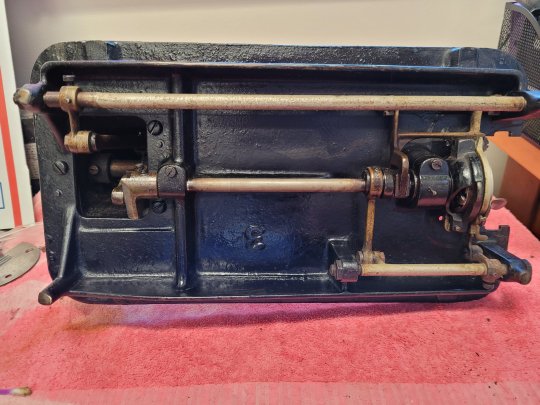

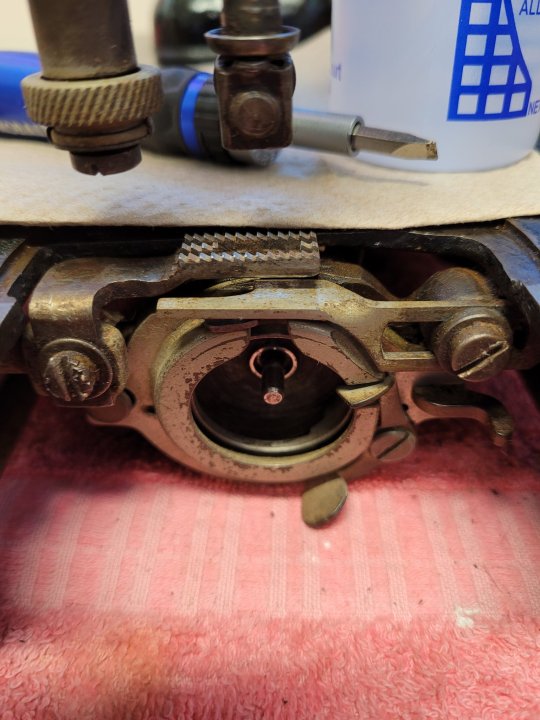
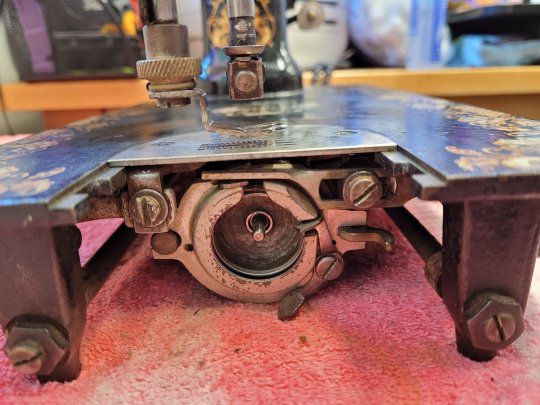
A couple more before (but after I’d started doing some cleaning with isopropyl alcohol) and after photos!
Some of that corrosion and plating chipping is not going anywhere but it all moved really well even before I cleaned things up and refreshed the oil so I’m happy to have stuff just a little cleaned up and shinier. The wear gives it character!
Since I wasn’t sure how much was rust vs corrosion, I gave the bars on the bottom a light sanding with 1500 grit sandpaper which already made a visual difference. Then went in with the alcohol to clean up the sewing machine oil buildups, and then polished the length with automotive polish while taking care to avoid getting it too close to any of the moving parts.
Out of all those screws in the bobbin area, literally the only one that would budge was the release lever for the bobbin case 8′) I don’t know how to free the seized screws all over this machine but I had to stop trying to get them so I didn’t strip them out. One of them was already pretty gouged before I got to it, so I assume the owners before my coworker were already struggling with them 10+ years ago.
I think I’ve got the machine all cleaned up to my liking! Most of the cleaning was purely aesthetic anyway. My plan for tomorrow is to bring in a new machine needle, some thread, and some scrap fabric to give her a hand turned test run to make sure everything’s working and timed correctly. Fingers crossed!
I started cleaning the dust off the cabinet and base today before realizing it was INCREDIBLY SILLY to do that indoors. So my other plan for tomorrow is to take it outside the office, give it a good dusting and then clean it with oil soap.
If I’ve got time after that, I’d like to apply wood filler to the drawer bottoms and the inside corners where things are gapping or outright broken. Thankfully the outside doesn’t look TOO bad, the veneer peeled a bit on one edge, but it’s laying pretty flat. All but one of the drawer handles broke off over time (thin wood filigree, unsurprising) and half of the replacement cup handles have also broken off, so I’m looking into ordering some pretty handles that are more my style. :3c
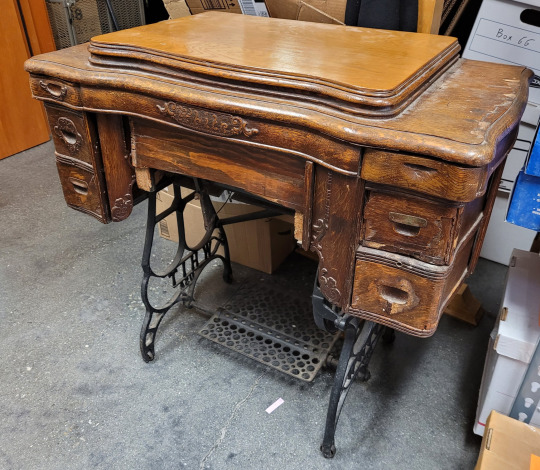
The one piece of wood damage that I really need to look into covering up and stabilizing is the front panel on the cabinet. The bottom third broke off over time and there’s another crack in the remainder, so it has a jagged edge and is missing the thin wood filigree that used to be there. I’d like to do something decorative that also helps protect the user from those sharp edges.
4 notes
·
View notes